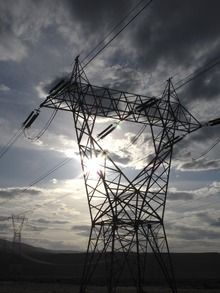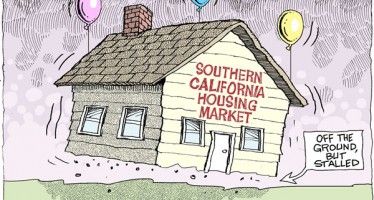Paint it Blackout: Will India-type power crashes hit Calif.?

By John Seiler
India is being hit with a series of blackouts that have crippled the country. It sounds a lot like California dipped in curry. From The Economist:
* India has “blackouts (during peak hours the system delivers 10% less electricity than customers want) and an inadequate grid that does not reach some 300m people.” In California’s case, it’s 37 million people. And we haven’t had blackouts in a decade only because the weather has been cool. (So much for “global warming.”)
* “There is also a risk that India cannot deliver the long-term increase in electricity generation that its economy needs to fulfil its potential…. Trapped in the middle are the firms that run power stations. In desperation they are importing pricier foreign coal, but the grid companies cannot afford the power it produces. With too little coal and wobbly customers, the private firms that have built new power stations are in financial trouble. Another wave of private investment looks unlikely.” In California, our anti-business regulations have forced the state to import 29.6 percent of our electricity from outside the state. See the explanation and chart below.
* “In India, though, no one expects perfect design. The economy sits somewhere between the old command-and-control approach and the new ways of markets and private capital.” In California, the mix is the same, but the sequence the opposite: The old ways were markets and private capital. The new ways are “command-and-control,” as in AB 32, the Cap-and-Trade scheme of the California Air Resources Board and such nutty schemes as Gov. Jerry Brown’s Browndoggle choo-choo train and the Delta tunnel.
* “The problem has been clear for ages. A circuitous blame game is taking place. Ministries squabble but no one knocks heads together.” Same thing in California.
* “Power, so vital for growth, is India’s biggest bottleneck. The danger is that it becomes a metaphor for the whole economy….” Same here. All that “green power” just isn’t going to provide enough juice.
* “Jawaharlal Nehru, the country’s first prime minister after independence, was obsessed with hydroelectric dams, calling them the ‘temples of modern India.’ It would have been good for India’s environment, and the world’s, had many more temples been raised. The fad for hydro trickled away and it now provides only 14% of India’s power compared with up to a half in the 1960s.” In California, we’re actually working to tear down our hydroelectric dams.
* “The subcontinent has plenty of sun and wind, and states including Gujarat and Tamil Nadu are keen to encourage investments in renewable energy. These are likely to be niche sources of power, thanks to problems getting land and their high cost.” Note the word: niche, not rich. In California, the obsession with expensive renewable energy is slamming the state economy.
* “As for nuclear power, India’s attitude has long been hyperbolic on paper and ambivalent in practice…. Events in Japan have not helped. ‘By the time people forgot Chernobyl, along came Fukushima,’ says one industry bigwig.” Same thing in California. No Nukes rules.
* “If the test is avoiding a national catastrophe, India’s power sector will pass it. But if it is delivering the infrastructure that can allow the economy to grow at close to a double-digit pace and industrialise rapidly, India is failing.” Of course, California hasn’t had double-digit annual growth in decades. It’s a stagnant economy, to a great extent because it doesn’t produce enough cheap energy to keep industry humming.
Poverty to middle class — and back again
Not all the analogies are exact. California now uses a lot more natural gas than India; while India prefers coal, which is the one resource they have in abundance. India is determined to raise its people from poverty into the middle class; while California’s elites, in government and business, seem determined to destroy the middle class — or drive it to other states.
Right now, the high tech is in California, while the call centers are in India. In 20 years, it will be the opposite. Then, the wealthy Indian middle-class will complain about how tech support is provided by Californians with Valley Girl accents.
——————————-
As to how much of California’s energy comes from out of state, my colleague Wayne Lusvardi told me, “According to the table below, the answer is 29.6 percent.”
|
Fuel Type
|
California
In-State Generation (GWh)
|
Percent of California
In-State Generation
|
Northwest Imports (GWh)
|
Southwest Imports (GWh)
|
California Power Mix (GWh)
|
Percent California Power Mix
|
|
Coal
|
3,120
|
1.56%
|
692
|
20,158
|
23,969
|
8.41%
|
|
Large Hydro
|
36,596
|
18.25%
|
74
|
1,430
|
38,101
|
13.37%
|
|
Natural Gas
|
90,725
|
45.26%
|
215
|
13,072
|
104,012
|
36.49%
|
|
Nuclear
|
36,666
|
18.29%
|
–
|
8,031
|
44,697
|
15.68%
|
|
Oil
|
74
|
0.04%
|
–
|
–
|
74
|
0.03%
|
|
Other
|
0
|
0.00%
|
–
|
–
|
0
|
0.00%
|
|
Renewables
|
33,292
|
16.61%
|
5,398
|
2,751
|
41,441
|
14.54%
|
|
Biomass
|
5,825
|
2.91%
|
419
|
–
|
6,243
|
2.19%
|
|
Geothermal
|
12,685
|
6.33%
|
–
|
574
|
13,259
|
4.65%
|
|
Small Hydro
|
6,130
|
3.06%
|
6
|
–
|
6,136
|
2.15%
|
|
Solar
|
1,058
|
0.53%
|
29
|
130
|
1,217
|
0.43%
|
|
Wind
|
7,594
|
3.79%
|
4,945
|
2,047
|
14,585
|
5.12%
|
|
Unspecified Sources of Power
|
N/A
|
N/A
|
21,339
|
11,381
|
32,719
|
11.48%
|
|
Total
|
200,475
|
100.00%
|
27,718
|
56,821
|
285,014
|
100.00%
|
Related Articles
Chevron refinery fire sets off money grab
Aug, 10, 2012 By Joseph Perkins Well, that didn’t take long. No sooner did Chevron douse the fire this week
Housing report by Legislative Analyst raises affordability questions
The California Legislative Analyst’s new report on housing costs puts numbers to what housing-hunters know on the ground: affordable housing
Blackout Shows CA Is Third World
FEB. 15, 2012 By JOHN SEILER More evidence California has descended into Third World status: Yesterday evening I sat in




